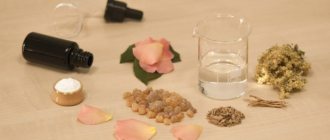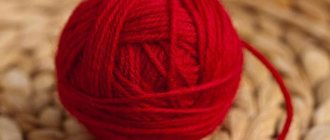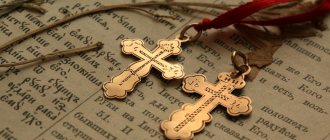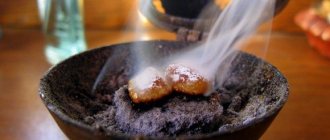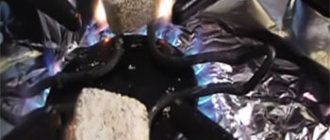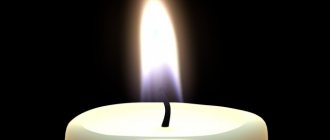And entering the house, they saw the Child with Mary His Mother, and, falling down, they worshiped Him; and having opened their treasures, they brought Him gifts: gold, frankincense and myrrh. (Matt. 2:11)
And the Lord said to Moses: Take for yourself fragrant substances: stakti, onycha, halvana fragrant and pure frankincense, half in all, and make of them, by the art of making ointments, an incense composition, erased, pure, holy, and grind it finely, and place it before [the ark ] testimony in the tabernacle of meeting, where I will reveal myself to you: it will be a great sanctuary to you; Do not make incense made according to this composition for yourself: let it be holy to you for the Lord; (Ex.30:34-38)
What is incense? How did he appear? Why is it used in the Church? Is it true that the scent of incense repels evil spirits? We have collected interesting facts about incense, information about its history and use, tried to answer all common questions about it and talk about how to use incense at home. There are many myths and superstitions associated with the use of incense. Most of them are not justified. Traditional medicine is full of recipes for incense. It is believed that a piece of incense can heal a number of diseases. How justified is the use of incense for medical purposes?
What is incense
We have known about incense since Biblical times. The gifts that the Baby Jesus received from the Magi were gold, frankincense and myrrh. What is incense? Frankincense is an aromatic resin obtained from a special genus of trees - Boswellia. One of them is called the Frankincense tree, and they grow on the Arabian Peninsula, as well as in East Africa. Frankincense essential oil is obtained by distilling the resin. This oil has a brighter, fresher, cleaner scent than frankincense resin. Therefore, people who attribute healing properties to incense often use frankincense essential oil. Its smell is more pleasant to the human nose.
The chemical composition of incense is quite complex. It has aromatic substances that give incense its rich scent. More than half of the composition (56%) is a resin made from free boswellic acid and associated olibanoresene. About 30% of incense is gum. The rest of the composition is various essential oils (terpenes, cymene, phellandrene and others). Scientists claim that the smoke from incense contains incensol acetate, which can have a psychoactive effect and lead a person to a state of euphoria. But for this to happen, the concentration of incense must be very high; this never happens during ordinary church services.
Why does the smell of incense make you sick?
Not everyone likes the smell of burning tar, and that’s normal, but it has already been proven that smoke has an antidepressant effect on the body. The properties of incense are determined by its composition, and it contains incensol acetate, which some narrow-minded people compare to marijuana. It is not clear whether this is addictive, but there are those who specifically attend services in order to breathe in plenty and experience the effect of euphoria.
Frankincense is a psychoactive substance, but so are essential oils used in aromatherapy. Some are designed to calm, others to invigorate. Another thing is that the smoke rising from the censer is a symbol of prayer ascending to God. After all, what it is – incense – is clear only to true believers who glorify Christ. And the one who came to the temple to “breathe” and get pleasure is a spiritual sensualist, and not a humble Christian. The essence of the Divine service is prayer and unity with the Lord, but nothing else.
The history of incense
The ancient Phoenicians traded incense. Caravans followed the valuable resin on the orders of the pharaohs. The Egyptians used incense in pagan rituals.
Frankincense resin is mined from remote regions of the Arabian Peninsula, Africa and India. On the Arabian Peninsula and North Africa, incense was worth its weight in gold, so the gifts of the Magi were quite valuable. Collecting frankincense resin was and remains to this day a very labor-intensive process, which is why the fragrant substance is so highly valued. The person who extracts the resin makes an incision in February or March in the bark of a tree that grows on limestone rocks in the desert. It will take two or three months for the juice to flow out of the cut and then harden into white drops that look like tears. Then the resin miner returns to the same tree to collect crystals of incense tree resin. He also collects the resin that has flowed onto the leaves specially folded below. The hardened resin can be processed to produce frankincense essential oil. It can also be crushed to be used as incense.
In Europe, incense appeared as a Frankish incense, as it was believed that the Franks (a union of ancient Germanic tribes) brought it there. It was indispensable for cosmetic purposes and many natural perfumes are still produced using incense. The quality of incense can be assessed by its aroma. Connoisseurs can tell whether the incense in front of them is premium or ordinary by listening to its aroma.
From one tree you can collect only 400 grams of resin. At the same time, several thousand tons of incense are produced per year.
Varieties and varieties of incense
Incense is divided into ordinary and selected. The resin that is collected from the tree and from the leaves is distributed into cleaner pieces that look like drops, have a light yellow or pinkish tint and when rubbed become a white powder. Not so clean, large and dark pieces are ordinary incense.
Incense is used not only in the Church. It is used in aromatherapy, making cosmetics and perfumes. Due to the amazing properties of incense, it was used in Egypt to embalm the dead, which is how mummies appeared. The Egyptians often used incense in their religious ceremonies. Some historians believe that the Jews learned to use incense during the time of Egyptian slavery, adopting this tradition from the Egyptians.
Can you carry incense with you?
Today you can find amulet on sale that looks like a small box, compact handbag or pouch. Inside there is tree resin, which is designed to protect its owner from both spiritual and physical threats. Incenses are worn around the neck along with a cross on the body or attached to clothing with a pin, but always above the waist. Those interested in how often the incense in the amulet should be changed should be answered that it cannot be changed, you just need to remove the bag before bathing, and when it gets dirty, transfer the contents to a new one and continue wearing it.
If for some reason the incense has become unusable, then it must be burned, the ashes buried in the ground and a new one purchased. Some believe that resin worn on the body for 3 months and buried on the territory of an active monastery can increase a person’s protection, but this is already an element of the occult and is not approved by the church.
Church incense
Incense has a specific smell. A person who comes to an Orthodox church for the first time can feel a bright aroma that will be remembered for a long time. This is what incense smells like. During the service, incense is lit on the burning coals of a censer, a metal bowl-shaped vessel suspended on several chains. When incense burns, fragrant smoke is formed - incense. Frankincense incense has always been used in the Orthodox and Roman Catholic Churches. The smoke of incense rising upward symbolizes the prayers of believers ascending to Heaven. The Old Testament contains detailed instructions on how to use incense. Incense is also mentioned in the Song of Songs. There it is called levona and is part of the incense, one of the 11 incense in the temple.
In large crowds of people, incense is useful as a disinfectant.
Incense is prepared in some monasteries. Previously, there was Sofrinsky incense. After the war, it was produced in the workshops of the Moscow Patriarchate. It consisted of a mixture of pine resin and ordinary chalk. Now incense is produced in the workshops of the St. Danilovsky Monastery. Jerusalem incense is also imported to Russia. It is often used at holiday services.
Many believers wonder about the famous belief that evil spirits do not like the smell of incense. There is no indication in the Bible that fallen spirits have any scent preferences or sensory organs that enable them to detect scents. The physical world has no influence on them. If there’s one thing the demons definitely don’t like, it’s spiritual activities, including prayer. In the temple, in addition to the aroma of incense, there is also the sincere faith of people, their appeal to God, all this really has power over evil spirits. Satan fell through pride; the humility of those who pray scares away evil. You should not attribute spiritual properties to incense. It refers to the material world.
How to use incense at home
Everyone knows well that in the temple they use incense during services. Can you use incense at home? Many believe that a house cannot be likened to a temple and incense, with the right to use it being the prerogative of the Church. In fact, it is not a sin to use incense at home. To a church-going Christian, the difference between home and church, between church services and cell prayer is obvious. Incense is simply a pleasant smell. Myths that it is used in churches to ward off evil spirits are nothing more than superstition.
Therefore, if a person wants to burn incense at home to pray, there is nothing wrong with that. If incense serves prayer, helps a person pray and focus on communicating with God, it can also be used at home.
Many people also use incense for medicinal purposes. To do this, you need to enlist the help of a doctor.
Frankincense essential oil goes well with orange, lemon and other citrus oils. It is also suitable for bergamot, pine and sandalwood oils. Frankincense essential oil has a woody, sweet, warm aroma. The country of origin and quality of the incense play a big role in how pleasant the incense will be and whether it has healing properties.
Incense is not dissolved in ether, water or alcohol. This emulsion loses its beneficial properties.
To light incense at home you will need a censer or brazier, coals, a candle and matches. Incense does not burn, so without a special device that maintains a high enough temperature, nothing will work. In church this is a censer, but at home an ordinary brazier, a metal plate or a bowl made of refractory material will do. A candle or lamp is placed under the container. Hot coal is placed in the container. Even the coal that is sold for hookahs will do. The incense resin begins to melt and release its aroma. The lower the melting point, the subtler and more pleasant the incense aroma will be. You shouldn’t go overboard with fumigating the room with incense. This may not have the best effect on the human body and cause headaches.
Useful tips
To light incense at home, you are required to purchase three things: a censer, charcoal and incense. A home censer is noticeably different from a church one. It is smaller in size and has a handle for convenience. Charcoal is made in the form of tablets that are easily lit with a match.
The tablet is taken with forceps. Heat it with fire on all sides. Wait until it sparkles. The smoke and sparks will go away in a few seconds. This means that harmful chemical compounds have evaporated. You can place burning coal in a censer. As soon as it cools down a little and is covered with ash, incense is placed.
After all the preparations, the lid of the censer is closed. The aroma of incense seeps through the holes and the cleansing of the house begins. The first object is the entrance door, which lets the negative into the room. Movement of the hand clockwise along the perimeter, and finally a triple cross - this is the action program for each room.
Don't forget about secret corners and hard-to-reach places. Everything is carefully fumigated with a sacred aroma. During the cleansing procedure, the “Our Father” is said. The room should be well ventilated. Don't rush to close the windows. Perhaps evil spirits are hidden somewhere and it takes time to expel them.
The healing properties of incense
Frankincense oil can also be used for medicinal purposes. Before we talk about what ailments incense can be useful for, we would like to note that any medical manipulations with incense should only be carried out with the permission of the attending physician. In addition, it is important to remember that prayer for health does not replace visiting a doctor. And, if you feel unwell, you should not rely solely on the healing properties of incense. Prayer in church is important; the Church knows many cases where people were healed through prayer even in the most difficult situations. However, you should definitely contact a medical facility.
Before the advent of modern medicines, frankincense was often used by doctors of the past. It is difficult to say how effective its healing properties are in each individual case, but it is believed that:
- Frankincense essential oil has antiseptic, tonic and disinfecting effects.
- Frankincense oil also has a sedative effect. Frankincense essential oil can be helpful in stressful situations.
- It may also have a diuretic effect.
- It is taken as an expectorant and astringent.
- Frankincense is also believed to strengthen gums and hair roots.
- Frankincense oil helps contract muscles and blood vessels.
- Normalizes intestinal function. Accelerates the work of gastric juice and peristalsis.
- Frankincense essential oil heals skin wounds, stretch marks and stretches the skin of the face.
- Has a positive effect on the female reproductive organs.
- In China, incense is used for joint inflammation.
- Aromatherapy with incense helps overcome the craving for smoking.
Frankincense is also used for massage mixtures: 5 drops per 20 grams of base oil or cream. To take an aromatic bath, one dropper of oil is enough. If you plan to add it to a ready-made shampoo, serum or cream, then the proportions are usually as follows: 4 drops of essential product per 15-20 grams of base. A couple of drops are added to tea or herbal decoction for internal treatment: for asthmatic cough, cystitis, gynecological inflammation.
Important: before using incense as a medicine, you should consult a doctor and in case of serious illnesses you should not rely only on incense. Frankincense essential oil is not used during pregnancy; it is not recommended for young children and people prone to allergic reactions.
- In 1922, the tomb of Tutankhamun was opened. Incense was kept in incense vessels sealed there. Thousands of years later, it still retained its aroma, which amazed the archaeologists who made this amazing discovery.
- Frankincense is mentioned in historical documents dating back to 2500 BC.
- If you inhale incense vapors for a long time indoors, you may get a headache.
- Incense is mentioned in the folklore of all Slavic peoples.
- The famous doctor of the distant past, Abu Ali Ibn Sina (Avicenna), wrote about the healing properties of incense.
- Excessive inhalation of incense vapor can cause addiction similar to drug addiction.
- Frankincense can cause hallucinations.
- People are allergic to incense.
- On Holy Mount Athos they also make incense. Incense is made in the Vatopedi monastery, and it is called “Vatopedi” incense.
- Incense can be of different colors - black, yellow, purple, depending on the chemical composition and aromatic oils used in its preparation.
Frankincense is one of the oldest incense in the world, dating back to the Bible. Nowadays, it is still used during services in Orthodox and Catholic churches, and is also widely used in perfumery and aromatherapy. At home, incense can be used as an incense, creating a wonderful atmosphere in the room and wonderfully calming the nervous system. But because it is a tree resin and is sold in hard pieces, people can often have difficulty smoking it.
You will need
- incense, censer or brazier, coal, lamp or candle, matches
Instructions
1.
Incense, like any other aromatic resins, is not itself a flammable substance. Consequently, to burn it, an external heat source is required, under the influence of which the incense begins to melt and emit fragrant smoke, that is, to smoke.
2.
Usually in churches, special vessels - censers - are used to fumigate a room with incense. A censer (or, as it is also called, a censer) is a closed metal vessel in the shape of an elongated bowl, suspended on chains. Hot coals are placed in it, and slices of incense or other fragrant mixture are placed on them. The smoke comes out through the holes in the censer and fumigates the room.
3.
In order to light incense at home, you will need a censer, a small brazier or a fireproof bowl in which you can place burning coals. It is also possible to use a primitive metal plate mounted over the open fire of a candle, alcohol burner or lamp. Slices of incense are laid out on a plate or coals and heated to the melting stage. The main thing to remember is that the lower the heat, the subtler the scent of the incense will be.
4.
As fuel for lighting incense at home, you can use charcoal tablets, which are sold in church shops or esoteric goods stores, with great fanfare. Charcoal is also suitable for hookahs. It is also sold in the form of small bars and tablets, which are convenient to use at home. Coal is ignited using ordinary matches. If difficulties arise, you can use a special charcoal lighter fluid, which is sold in hardware stores.
5.
When fumigating an apartment or house with incense, it is necessary to keep in mind that its strong smell in excess concentration can cause headaches and dizziness. Therefore, when lighting incense in an apartment, make sure that the room is well ventilated and do not close the vents or windows during each fumigation time, so as not to harm the health of those present.
Video on the topic
People who comprehend the secrets of esoteric teachings have probably heard about such a substance as incense. This is a powerful remedy used to combat unclean entities that can settle not only in the house, but also firmly cling to a person’s energy shell, and in order to get rid of this, you need to know how to use incense to cleanse the aura around you. This substance, which is insoluble in water and is a resin, begins to smoke strongly if it flares up strongly, so it is worth using incense, following certain recommendations, in order to obtain the desired effect. Many people are familiar with the smell of the unique exotic resin, especially those who are churchgoers. It is recommended to use incense at home in order to reduce emotional arousal and tension; its smoke can make breathing measured and heart rate uniform. If you need to use incense, it is best to use a special aroma lamp - a lamp. Before using incense in a lamp, you need to light the wick in it, and then place a metal attachment on it, where a piece of incense is placed. Incense begins to emit an aroma as soon as the stand heats up, filling the room with a light, specific smell that is already familiar to many. You can use incense in another way, for which you will need charcoal, sold in any esoteric store or shops at churches. If there is a hookah in the house, then charcoal is also suitable for it. You need to use incense starting with lighting the coal with matches. After calcining it, you should wait 15 minutes until it cools down. Only after that a piece of incense is placed on it. It is unacceptable to burn incense on a hot coal. If there is a censer that is designed specifically for using incense, then for it the coal is pre-heated on a gas stove until it is hot on both sides. The red piece of coal is then moved with tongs or tweezers into the censer, after which the incense can be used by spreading it around and covering it with a lid. Do you want to fill your home with church scent to cleanse it of accumulated negativity, but don’t have any incense? It can be replaced with incense candles, which are made using incense, as well as charcoal and aromatic additives. It is also worth remembering, when deciding to use incense to fumigate your home, that you need to monitor the concentration of the smoke, because it is quite heavy, so its excessive evaporation can lead to dizziness. In this case, it is recommended to light incense in a room that can be ventilated if necessary. Tips *You can fill your room with the aroma of incense if you use aromatic oil based on it. To do this, add no more than 8 drops to the aroma lamp. However, it is not recommended to stay in such a room for more than 15 minutes. *************************************** ALSO SEE THE BEST RECIPES. SEE THIS LINK
Every person who once visited the temple felt that special majestic and solemn atmosphere. This atmosphere is invariably created over a long period of time thanks to icons, church architecture, stained glass windows and dim lighting. Of course, everyone who has ever been to a church also felt that elusive aroma that always accompanies the church. This scent is a little sweet, a little spicy and of course soothing. This aroma is created by burning a substance called incense. Incense is also used during all church ceremonies.
Incense - what is it, composition and properties
Incense is a special substance obtained from resin and has a strong aroma. The resin from which incense is made comes from a small tree that belongs to the cistaceae family, native to the Arabian Peninsula.
To extract resin, a special cut is made in the tree bark, and the resulting liquid is dried. There are two varieties of incense, which differ in the method of extraction:
- The collection of whole pieces of hardened resin is selective.
- Collecting resin residues from bark and soil is common.
The next step is to grind the hardened pile of resin into powder. The process is carried out using a mortar.
The resulting powder is actually a substance called incense, which must be set on fire for the aromatic properties to appear.
It is important to note that a special variety of trees, cistus, is considered a rare plant, so incense is quite a valuable material.
During the times of Ancient Rus', incense was the center of many pagan rituals. They used to ward off evil spirits by placing incense in their homes. In addition, healing and rejuvenating properties were attributed to incense.
Composition and types of incense
Incense is a processed product obtained from resin. The so-called true incense, also known as “dewy” or “lebanese,” is obtained from resin extracted from the very rare Boswellia tree, the birthplace of the tree is considered to be Arabia, and it can also be found in East Africa and India.
In Russia, this tree is called Lebanese cedar.
Lebanese cedar is divided into several types, which are distinguished by the type of incense produced:
- Pupirifera, is native to Ethiopia and also Somalia. Varieties of incense from this tree are called "African" or "Abyssinian" incense and "Somali" incense.
- Carteri, located in Arabia. The incense from this tree is called “Arabian”. It is also called pure and real incense.
- Serrara, grows in areas of India as well as Persia. It is called "Indian" incense. This resin has been part of various balms and ointments, as well as medications, for a long time. Resin from the bark of this tree is imported into Russia in large quantities. This variety of incense has a sweet, lemony aroma.
The Boswellia tree has the ability to grow only in a very limited climate zone and requires a large number of conditions that cannot be artificially replicated.
That is why it is listed on the pages of the Red Book.
The limited number of trees and the complex process of extracting the resin and processing it into incense make it very valuable, hence the number of artificial substitutes.
Real incense is most often made in places where trees grow. It is possible to collect no more than 400 grams of resin from one tree.
The procedure for collecting resin, as well as its preparation, begins at the end of winter or beginning of spring, this is determined by the climate of the area. It is best to collect resin before the rainy season. And also before the sap begins to move up the trunk.
Using sharp axes, a deep cut is made in the bark. The secreted sap in large quantities covers the tree trunk and then moves to the ground.
The juice has a milky tint. Once the sap hardens into resin, assembly begins. The process of hardening the juice itself is quite long.
Incense has a rather complex composition, including a variety of aromatic substances. A large concentration in the composition is certainly occupied by the resin itself, consisting of boswellic acid, as well as olibanoresen. Next in percentage of content comes gum.
A tenth of the composition is occupied by various essential oils and their mixtures. For example, incense may contain cymene or phellandrene. When burned, incense releases incesol acetate. It is he who is responsible for aromatherapy when using incense. This acetate can put a person into a euphoric state.
Properties of incense
Frankincense has many beneficial properties, some of which are medicinal:
- Experts note that using incense can speed up the treatment of diseases associated with the urinary tract.
- Able to cope with stomach disorders and problems with the functioning of the gastrointestinal tract.
- Is a good antiseptic.
- An excellent remedy for the treatment of arthritis and rheumatism.
- Able to cure varicose veins.
- Frankincense is a good remedy for various inflammations of the skin, rashes and acne.
- Puts in order the shattered nervous system.
- Can replace antibiotics in the fight against colds.
- Able to cure fungal as well as bacterial infections.
- Frankincense is a great way to improve memory.
- In addition, incense is often used in cosmetology, cooking and aromatherapy. In cosmetology, resin is added to various masks, anti-aging products and cleansing cosmetic products. Aromatherapy using incense helps calm nervous conditions and overcome long-term depression.
You can also use incense to get rid of the bad habit of smoking. Aromatherapy with incense helps reduce the urge to inhale tobacco. There is also a special recipe with which you can give up cigarettes forever.
You need to prepare a special tincture, the composition and method of preparation are quite simple. You need to take about 250 ml. alcohol, as well as resin. You need to use about 10 teaspoons of resin. The resin must be crushed.
The ingredients are mixed and placed in a dark place for several days. Once the tincture is ready, you can begin to use it. It's important to do it right. It is recommended to dissolve the tincture in clean water, 20-30 drops per 100 ml. clean water.
You can also rinse your mouth with the tincture. To do this, you need to take a couple of teaspoons of tincture and dissolve them in 50 ml. clean water. You can gargle with the solution several times a day.
Laboratory tests conducted in the United States have found a link with the use of incense and the damage to cancer cells. At the same time, healthy cells were not damaged when using incense. The researchers specially grew cancer cells in vitro and treated them with Carteri frankincense extract.
The study found that frankincense actually first stopped the growth of cancer cells and then destroyed them. American experts are confident that incense should be introduced into medicine and used as an alternative to traditional therapy for the treatment of cancer. Moreover, the alternative is a more budget-friendly option and will therefore be available to a wider range of people.
History of use to the present day
History knows that Christianity was not the first to use incense. Long before this, the beneficial properties of incense were discovered by the Phoenicians.
They were engaged in his trade. In Ancient Egypt, incense was used for incense in temples.
Incense was used as a gift to offer to the gods, and it was also used during funeral services for the departed.
Even then, the Egyptians noticed that incense can have a calming effect on a person, as well as put him into a shallow trance.
Also, the inhabitants of Ancient Egypt added resin to medicinal potions, and women also used resin for cosmetic purposes.
Egyptian women made anti-aging masks with the addition of resin.
People also believed that the smoke emanating from burning incense could drive away evil spirits.
The Egyptians also believed that the soul of the deceased departed along with the smoke emanating from the incense.
Useful recipes based on incense
Frankincense tincture
You can prepare an alcohol tincture of incense on your own:
- You need to take 7 grams of incense.
- Combine with 15 ml of alcohol.
- Leave to infuse in a dark place for a week.
- The healing composition should be used 2 times a day, 10 drops before meals.
- The composition perfectly helps to get rid of stomach pain, throat diseases, and gonorrhea.
Frankincense ointment
You can also prepare an ointment at home:
- Take 10 grams of raw materials.
- 100 grams of Vaseline and combine everything.
- Place in a water bath until completely dissolved.
- This ointment perfectly helps to cope with joint pain, get rid of purulent wounds and boils.
If your child is sick, you can put a napkin smoked with incense on his chest at night. Recovery will come much faster. To calm frayed nerves, you can massage or take a bath using the plant’s oil.
Before you begin therapy with such an excellent remedy, you need to find out whether there are contraindications to the use of incense. Otherwise, you can only cause harm to your body.
Using incense at home
You can purchase incense in shops selling candles at any Orthodox church. You can also order from a large number of online stores specializing in Orthodox topics. Many people do not know what incense is or how to fumigate a house or apartment with incense.
Incense, depending on where it is made, can have a varying aroma. A standard container for sale holds up to 500 grams of incense. This amount is enough for 14 days with active use.
You can also buy small boxes of incense in churches. It is also important to know how to properly light incense pieces.
At home, to light incense purchased in solid form you will need:
- censer or lamp;
- incense coal;
— directly incense in solid form.
I have this kind of incense, I bought it at a church store. Pink, with a rose scent, very pleasant, but you don't need to use much of it. If you use 2-3 pieces, it will be difficult to breathe. 1 piece is enough.
There are several ways to light incense:
- Using a censer.
- Using a lamp.
A censer is a container made of metal or ceramics into which special coal is placed.
If the charcoal is covered with white ash, it is ready for use. Next, the heated coal is placed in the censer, and incense is laid out around the coal.
The aroma begins to spread within a fraction of seconds. To spread the aroma throughout the living area, you can carry the censer around the room.
The advantage of using a lamp instead of a censer is the absence of coal. Instead of coal, you must use a lamp attachment made of metal.
First of all, the lamp itself is lit, then you need to place the nozzle on it and place a piece of incense on top. With this method, you will have to wait a bit for the aroma from the incense to spread.
